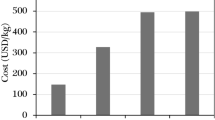Abstract
In this work, the squeeze infiltration process is employed to synthesize a lead–fly-ash composite. Infiltration was achieved by forcing molten lead to penetrate a fly-ash preform. Among the variables investigated is the ratio of urea to birch sawdust in the induced porosity of the preform. Experimental results show that the squeeze casting technique can be successfully used in the synthesis of the lead–fly-ash composites with a uniform distribution of fly-ash cenospheres. Conditions were found where total infiltration of lead–fly-ash composites was achieved. In this case, all the fly-ash cenosphere surfaces became encased by lead. In addition, the external composite surface consisted of a layer of pure lead as its intended use was as light battery electrodes. Corrosion testing in a 95%, H2SO4 solution indicated that the corrosion resistance of this composite was as good as the one found in pure lead.
Similar content being viewed by others
REFERENCES
J. J. Lewandowski, SAMPE Quart. 20, 33, (1989).
M. Stefanescu, A. Moitra, A. S. Kacar, and B. K. Dhindaw, Metall. Trans. A 21A, 231 (1990).
J. P. Rocher, J. M. Quenisset, and R. Naslain, J. Mater. Sci, Lett. 4, 1527 (1985).
H. Fukunaga and M. Kuriyama, Bull. JSME 25, 842 (1982).
C. H. Adderson and R. Warren, Composites 15, 16 (1984).
T. W. Clyne, M. G. Bader, G. R. Cappleman, and P. A. Hubert, J. Mater. Sci. 20, 85 (1985).
T. W. Clyne and M. G. Bader, Proc. ICCM5, W. C. Harringan, J. Strife and A. K. Dhingra, eds. (TMS-AIME, Warrensburg, PA, 1985), p. 755.
G. R. Cappleman, J. F. Watts, and T. W. Clyne, J. Mater. Sci. 20, 2159 (1985).
J. M. Chou and D. D. L. Chung, J. Mater. Sci. 28, 1435 (1993).
Shy Wen Lai and D. D. L. Chung J. Mater. Sci. 29, 3128 (1994).
T. W. Clyne and J. F. Mason, Metall. Trans. A 18A, 1519 (1987).
A. Mortensen, L. J. Masur, J. A. Collie, and M. C. Flemings, Metall. Trans. A 20A, 2535 (1989).
A. Mortensen and T. Wong, Metall. Mater. Trans. A 21A, 2257 (1990).
A Mortensen and J. A. Cornie, Metall. Mater. Trans. A 18A, 1160 (1987).
T. R. Jonas, A. Cornie, and K. C. Russell, Metall. Mater. Trans. A 26A, 1491 (1995).
R. Asthana, Metall. Mater. Trans. A 26A, 1307, (1995).
Lead for Corrosion Resistant Applications (Lead Industries Assoc., New York, (1974), p. 95.
Author information
Authors and Affiliations
Corresponding author
Rights and permissions
About this article
Cite this article
Deqing, W., Ziyan, S., Hong, G. et al. Synthesis of Lead–Fly-Ash Composites by Squeeze Infiltration. Journal of Materials Synthesis and Processing 9, 247–251 (2001). https://doi.org/10.1023/A:1015526217424
Issue Date:
DOI: https://doi.org/10.1023/A:1015526217424




